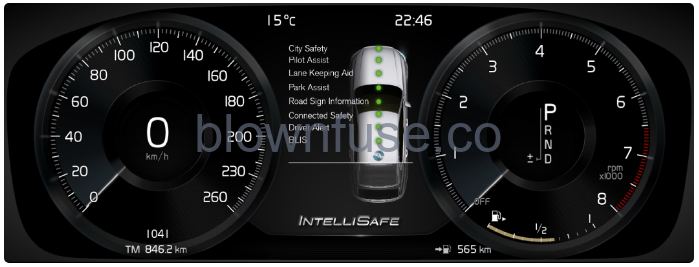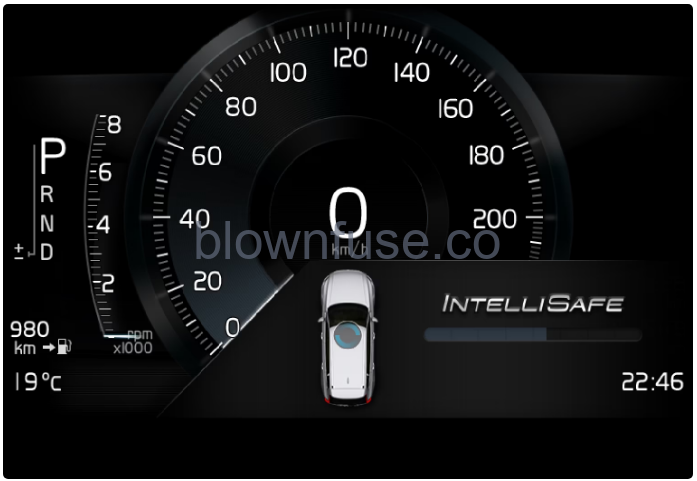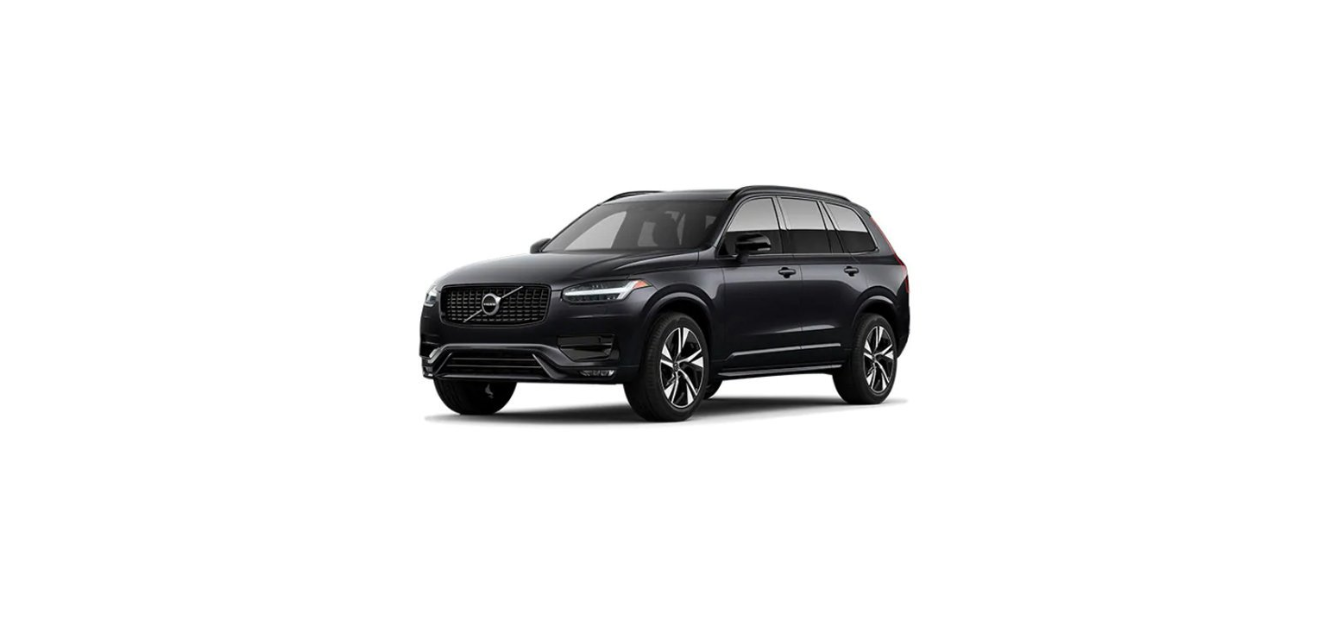2022 XC90 Volvo Driver support

Driving support systems
For example, the systems can help the driver to:
- maintain a set speed
- maintain a certain time interval to the vehicle ahead
- prevent a collision by giving a warning to the driver and braking the car
- help the driver to park.
Some of the systems are fitted as standard while others are options – which alternative applies is market dependent.
The driver support systems are only supplementary aids – they cannot handle all situations in all conditions.The driver always bears responsibility that the vehicle is driven safely and that applicable road traffic rules and regulations are followed.
Safety check of driver support when starting
The safety check is shown in the driver display

The illustration shows the 12″ driver display

The illustration shows the 8″ driver display
The green dots indicate that everything looks OK. If any system needs an additional check, this is shown by an orange dot and a message in the driver display.
Available driver support systems may vary depending on the market, options, car model and model year.
Warnings from various driver support systems
There are several functions in your car that can contribute actively to increasing safety in traffic, both for yourself and other road users. You have the option of viewing a list of some of the functions and what they may do – the aim of this is to ensure you are not surprised by the activation of any of the functions. If a function should be activated, you can also be informed of this via a text message in the driver display.
Read the individual sections on each system in order to fully understand the functions and learn about important warnings.
The driver support functions in your car can alert you in different ways. For example, with vibration in the steering wheel, brake pulse, with visual or acoustic signals or via symbols in the driver display.Alerts can also be shown in the head-up display.
City Safety™

City Safety is a function that can prevent or mitigate a collision with pedestrians, cyclists, larger animals or vehicles. Visual, acoustic and brake pulse warnings are given in the event of a risk of collision to help the driver act in time. If the driver does not react to the warning and the risk of collision is assessed as imminent then City Safety can automatically brake the car.
- Brake pulse warnings, visual and acoustic signals.
- The car brakes in certain situations if the driver does not react him/herself within a reasonable amount of time.
Steering assistance at risk of collision

The function of collision avoidance assistance can help you reduce the risk of the car unintentionally leaving its lane and/or colliding with another vehicle or obstacle. The function can assist you by helping to steer the car back into its own lane and/or steer it aside.
Your experience of the function may therefore differ depending on which of the subfunctions is activated.
- Steering assistance upon the risk of run-off.
- Steering assistance upon the risk of a head-on collision.
- Steering assistance upon the risk of rear-end collision.
Lane Keeping Aid (LKA)

Lane assistance can help you to reduce the risk of the car unintentionally leaving its own lane. Since you have the option to choose the setting for how the function should assist you, your experience of the safety function may vary.
- Steering assistance: If the function detects that the car is approaching a lane line, you will feel a gentle steering action applied to the steering wheel. You must have both hands on the steering wheel for the function to work.
- Warning: If the function detects that the car is approaching a lane line, you will be alerted by vibration in the steering wheel.
- Both: You are alerted with vibration and a gentle steering action is applied to the steering wheel.
Rear Collision Warning (RCW)

Rear Collision Warning is a system that can help you avoid being hit by a vehicle approaching from behind. If the system detects a risk of rear-end collision, it can give a warning and take the following action, depending on the conditions.
- Intensive flashing with the direction indicators.
- At low speeds, the function can tension the seatbelts by activating the seatbelt tensioners, and also activate the Whiplash Protection System.
- If the car is stationary, the foot brake can be activated.
Blind Spot Information (BLIS)

BLIS is designed to give a warning of rapidly approaching vehicles as well as vehicles diagonally behind and to the side of your vehicle so as to give you assistance in heavy traffic on roads with several lanes in the same direction.

- Alerts with an indicator lamp in the side mirror, with a fixed glow and flashing light.
Driver Alert

The function is intended to attract the driver’s attention if he/she starts to drive less consistently, e.g. if he/she becomes distracted or starts to fall asleep.
- Acoustic signal combined with a symbol in the driver display and a message.
Distance Warning

Distance Warning can alert you if the time interval to the vehicle ahead suddenly becomes too short.
- Warning light and/or a symbol in the windscreen Head-up display. To have the function, the car must be equipped with a Head-up display.
Cross Traffic Alert (CTA)

Cross Traffic Alert is a function designed to alert for crossing traffic when the car is being reversed.
- Acoustic signal from left or right-hand speaker, depending on the direction from which the object is approaching
- Icon in the driver display
- Icon in the park assist camera’s top view
Roll Stability Control (RSC)

Roll Stability Control is a stabilizer system that, in certain situations, can help to reduce the risk of overturning, for example, during sudden evasive maneuvers or if the car skids. If the system registers that there is a risk of the car overturning, it can react with the following action:
- Engine torque is reduced.
- One or more wheels are braked.
The functions described are supplementary aids – they cannot handle all situations in all conditions. The driver always bears responsibility that the vehicle is driven safely and that applicable road traffic rules and regulations are followed.
Speed-dependent steering force
In rare situations, the power steering may need to work at reduced power, and turning the steering wheel may then seem slightly heavier. This may occur when the power steering becomes too hot and it then needs temporary cooling. It may also occur if the power supply is disrupted.

In the event of reduced power, the message Power steering Assistance temporarily reduced is shown, as well as this symbol in the driver display.
While the power steering is working at reduced power, the driver support functions and steering assistance systems are not available.
If the temperature increases too much, the servo may be forced to switch off completely. In such a situation, the driver display shows the Power steering failure Stop safely message, combined with a symbol.
Steering wheel resistance can be adjusted when using INDIVIDUAL drive mode.
- Tap on Settings in the center display’s top view.
- Select .
Steering wheel resistance selection can only be accessed if the car is stationary or is moving at low speed and in a straight line.
Drive modes when using time intervals for vehicles
Selection is made via the drive mode control DRIVE MODE.
Select one of the following options:
- Eco – The driver support focuses on good fuel economy, which means longer time intervals to the vehicle ahead.
- Comfort – The driver support focuses on following the set time interval to the vehicle ahead as smoothly as possible.
- Dynamic – The driver support focuses on following the set time interval to the vehicle ahead more closely, which in certain cases may mean heavier acceleration and braking.

